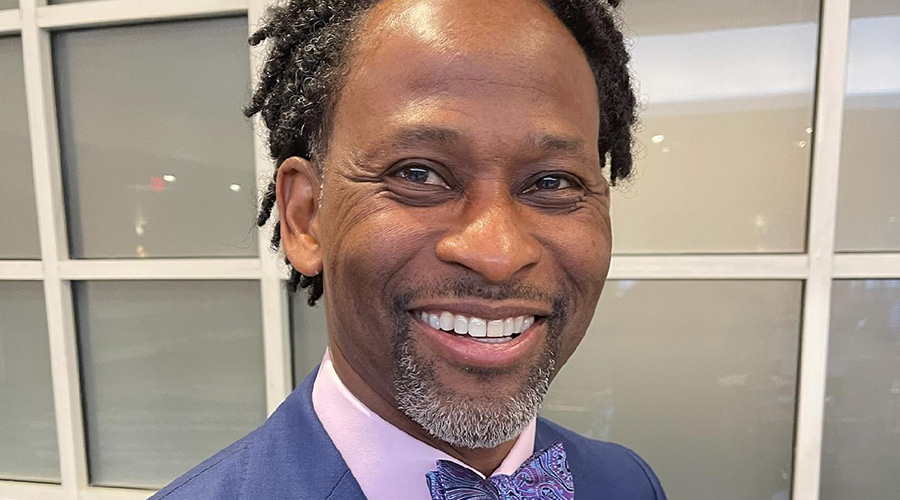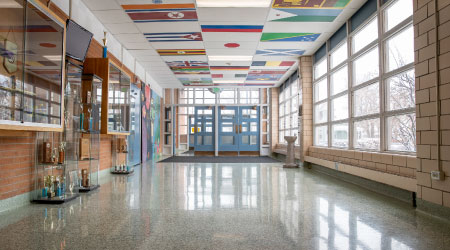Building Boom
North Carolina school officials asked the public for 17 new schools and $380 million in renovations. The real challenges started when voter said, "Yes"
To put it mildly, Wake County (N.C.) Public School System is experiencing growing pains. The district, which serves 127,000 students, expects to grow by more than 7,000 students for 2008. It projects the population boom to continue for at least three more years, with more than 8,000 additional students every year.
To meet the demands of growing enrollment, the district is taking the concept of school improvement to a new level. Last November, taxpayers approved the district’s Blueprint for Excellence 2006 plan, which calls for the construction of 17 new schools by 2010 and devotes more than $380 million to renovate existing facilities.
“We were very pleased with how the community looked at the renovations in conjunction with the population growth,” says Joe Desormeaux, the district’s senior director of maintenance and operations. Because the population growth is so great, it would be easy for the community and district officials to make school construction the highest priority and delay renovations in existing schools, he adds.
Desormeaux credits the district’s commitment to renovate its existing schools, in part, to his department’s involvement in creating the plans, which have been in the works since March 2003. As part of the planning team, Desormeaux was heavily involved in reviewing the project’s design and scope, identifying inefficiencies in the schools, and prioritizing upgrades.
Assessing the Situation
One of the plan’s goals is to eliminate the district’s backlog of deferred renovation and life-cycle replacement projects by 2015. Because the district has about 150 schools, each with its own renovation and repair needs, prioritizing has been a challenging task.
To determine which schools most needed upgrades, Desormeaux gathered data on the facilities’ conditions.
“We’re so big that data has become critical,” he says. When discussions about the bond began, Desormeaux and other planning team members analyzed all of the projects the district wanted to complete in 20 years.
Desormeaux used software to chart the expected life cycles of equipment at the schools. This information has been helpful in predicting equipment replacement needs.
“When a particular school is coming up on a five-year, 10-year or 15-year cycle, we know what needs to be replaced,” he says. For example, “between 2010 and 2015, all the schools that we built in the early 1990s are going to be approaching their 20- to 25-year life-cycle replacements. So we can expect to see a big jump in the need for renovations in those years.”
He also created a matrix that helps prioritize projects based on their impact on occupant safety and health.
“So if a piece of equipment ranks high in safety, and the end of its life cycle is expected to happen in the next year, that replacement has the highest priority,” he says.
The district also gave high priority to facilities that have not undergone a whole-building renovation within the last 40 years.
“A lot of things happen in 40 years,” Desormeaux says. At that point, the district will make any equipment life-cycle replacements, as well as major renovations to meet the changing demands of the educational program. This might include moving walls to enlarge classrooms. During whole-building renovations, the district also will make any modifications to meet guidelines and regulations set by the Americans with Disabilities Act (ADA) and U.S. Occupational Safety and Health Administration.
The planning team also created a list of assumptions that helped prioritize the various renovation projects. For example, the list states that whole-building renovation projects will be prioritized using the facility-condition index, with an emphasis on indoor air quality, health and safety and infrastructure preservation.
“We spent a whole lot of time developing the assumptions because once those are set, it lays the ground work for determining which schools need to get done first and how much we can get done during a time period,” he says.
Once the district’s board of education and board of commissioners for the county agreed on the plan, Desormeaux joined district officials in explaining the details of the bond to the community.
“I was involved in giving presentations to the public about the bond,” Desormeaux says. During these presentations, he explained the details of the planned renovations to parent and teacher groups and other organizations, including how the district estimated the costs for the renovations.
“Typically, there would be someone at the meetings who was not school affiliated, like a board member, who would market the bond,” he says. Then, Desormeaux and others from his department would present the facts that related to the renovation projects.
Aiming for Equality
When school districts undertake district-wide renovation and expansion plans, equality among the new and old facilities is a common concern for residents in the community. Before finalizing the proposal for the bond, Wake County school officials talked with people in the community about the equity issue.
“The new schools we’re constructing tend to be in the outlying areas because that is where the growth is happening.” Desormeaux says. “So you have people in those areas who want new schools, but then you had people in the older parts of the county who want their schools renovated so they are equal.”
Desormeaux was involved in identifying facility differences and looking for ways to overcome inequalities.
“If you’re renovating an existing school, you have an existing footprint that you can only go so far sometimes,” he says. As a result, it might be impossible to renovate an older facility so it meets the same specifications of a new school. For example, classrooms tend to be bigger in the new schools, and there might not be enough space in an older school to make the classrooms bigger.
“So we made an assumption in the plan that the space in existing schools will be considered adequate if the size is not less than 75 percent of the approved spaced standards,” he says. The plan also requires the amenities in renovated schools to be the same standard as new schools. Desormeaux is involved in determining the specification for the finishes and the equipment.
“We also included funding for replacement of furniture, equipment and technology if required,” he says.
Avoiding Interruptions
The physical work of the renovations and construction projects are scheduled to begin later this year. During these projects, Desormeaux makes arrangements to accommodate students. In some cases, the district uses untraditional strategies to meet the needs of the growing population.
“Usually, we’ll put the ninth and tenth graders only in the new high schools and let the population grow from there,” he says. “This year, we have a new high school that will also house some elementary students who are waiting for a new school to be built.”
The district needed to make some modifications to the high school to accommodate the elementary school students. For example, the district altered some restroom fixtures to comply with the ADA guidelines for young children. Desormeaux advises managers to be involved in the plans for such projects to ensure costs related for building modifications are included in the project’s overall budget and don’t wind up in the maintenance department’s operating budget.
Often, the district uses trailers and modular units to accommodate students in overcrowded schools.
“The maintenance department gets involved in acquiring the trailers and specifying the types of units that are being built,” Desormeaux says. “Our mobile population has grown immensely during the past couple of years. I think we have more than a 1,000 now.” In the past year, the district has built three modular schools and plans to use them as swing space during upcoming renovations.
To prepare for future population growth, district planners are designating areas for trailers and modular units on the sites of its new schools.
“It is already on the site plans where the additional modular units would go,” Desormeaux says. To handle overcrowding, the new schools also feature common areas, such as cafeterias, that are designed to handle more students than the building’s classroom capacity.
“We size them to handle additional students from six trailers,” he says.
Ensuring Success
In addition to participating in building inspections, Desormeaux’s department helps with maintenance issues that arise during the renovations. For example, workers might cut the wrong power line and his department responds to restore power.
The work doesn’t end once the construction and renovations are complete.
“As the new schools open, we need to get the buildings and equipment into our computerized maintenance management system and set up the preventive maintenance schedules,” he says.
Over the years, district officials have realized the maintenance department’s importance in ensuring the long-term success of construction and renovation projects, Desormeaux says.
“Maintenance didn’t play as big of a role in the earlier bonds,” he says. “We didn’t have any assessments before and decisions were driven by the principals and the area superintendents.”
Now, his department serves as a critical resource in assessing the schools’ conditions, determining the need for building improvements and ensuring the projects deliver the intended benefits.
Year-Round Schools: The Impact on Maintenance
Due to population growth, Wake County (N.C.) Public School System provides year-round educational programs in several of its schools, including its new elementary and middle schools.
“We’ve started doing this a couple of years now,” says Joe Desormeaux, the district’s senior director of maintenance and operations. The year-round schedule allows the schools to accommodate 20-30 percent more students.
Students in the year-round schools are separated into four rotating tracks. They attend school for 45 days and are on vacation for 15 days. At any given time, students from three of the four tracks are in the school.
“We are increasing the number of year-round schools from about 20 to almost 50 next year,” he says.
With the new educational calendar, Desormeaux’s department no longer has the luxury of scheduling maintenance projects during summer, when traditional schools have few occupants. So, he is looking at new strategies to complete major projects.
“We’re seriously looking at second-shift options,” he says. “We’ll also have to work closer with the principals to find periods in the year that we can schedule to do projects, such as reseal floors.”
The new schedule also will affect his department’s operating budget.
“We have to calculate how much more it would cost us in utilities and maintenance to maintain a year-round school versus a traditional school,” he says.
It is difficult to predict how much maintenance costs will increase because the district doesn’t have much maintenance-related data on year-round schools.
Utility expenses for year-round schools also are difficult to estimate. Because every school is built differently and features different equipment, each one uses a different amount of energy and water. So analyzing the utility costs of a traditional school doesn’t help in estimating the costs for a year-round school.
Desormeaux says he is confident of one prediction — switching to a year-round calendar will require a new maintenance strategy, but it will get easier over time.
— Renee L. Shroades
|
Related Topics:











